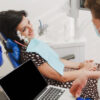Sleep Appliances

How MicrO2 Works
The MicrO2 device holds your lower jaw in a slightly forward position, thus gently moving the throat tissues away from the back of the throat. This opens the way for airflow and helps reduce snoring and Obstructive Sleep Apnea.
MicrO2 device is custom made to uniquely fit each individual that it is fabricated for. The device comes in two parts. One device fits over your upper teeth and one over your lower teeth. The device will also have a series of additional Upper or Lower devices; each one in the series is designed to move the jaw forward stepwise. There are no confusing mechanisms to adjust on the actual device. Jaw advancements can be easily achieved by simply removing the current Upper or Lower device and inserting the next Upper or Lower device in the MicrO2 advancing series.

How to Get MicrO2
Only a dentist can provide you with a MicrO2. Specially trained dentists play a key role in screening for Obstructive Sleep Apnea. Then, partnering with medical doctors, a dentist can provide the MicrO2 to treat those suffering from Obstructive Sleep Apnea as well as individuals needing an alternative therapy to CPAP.
If you have not already been diagnosed with Obstructive Sleep Apnea
You may wish to seek a diagnosis from your own medical doctor. Or, a specially trained Sleep dentist can offer you a pre-screening assessment. To get you started, the dentist you select will examine your mouth and ask you some questions relating to your health and sleep history. Depending on your screening assessment, you may be offered a home sleep test or be referred to a medical physician for a sleep study and diagnosis. Oral appliances for the treatment of OSA will not be covered by medical insurance, unless you have an actual diagnosis of OSA. Once you have a diagnosis, you may choose to have an oral appliance and return to your dentist for a MicrO2device.
If you have already been diagnosed as suffering from OSA
If you are seeking a new treatment option, you may wish to try an oral appliance. If you are a CPAP user and are noncompliant or have difficulty adapting to the regular use of CPAP, or if you have worn other oral devices but found them too complicated or cumbersome, you may want to try the MicrO2 device. The MicrO2 is the smallest, easiest and most comfortable oral device and is effective in keeping your jaw forward at night and your airway open while you comfortably sleep.
Final Steps
Once a MicrO2 device has been decided upon, your dentist will take dental molds of your teeth and measure and record a bite registration with your lower jaw in a forward position. These dental records will then be sent to the dental laboratory where the device will be custom made for you. The MicrO2 device will be manufactured in an FDA-registered dental laboratory. When your device arrives from the laboratory, your dentist will examine it for proper fit and function. Finally, your dentist will show you how to insert, remove, clean, and care for your device.

Current CPAP Users
The MicrO2 device can be a comfortable option for patients who are unable to wear their CPAP. The gold standard for treating OSA is with CPAP therapy, however many patients are uncomfortable with CPAP therapy or have lifestyles that are not conductive with this type of therapy. There is good news though. Sleep devices provided by dentists are playing an increasingly important role in the treatment of OSA. Jaw repositioning sleep devices are designed to hold the jaw in a forward position that opens the airway and limits the risk of soft tissue obstructing the airway.
Research studies have shown that using an oral appliance such as the MicrO2 can assist in alleviating symptoms of Obstructive Sleep Apnea and snoring by holding your lower jaw forward during sleep. The use of MicrO2 can enhance the quality of your sleep, as well as lessen daytime sleepiness, irritability, sluggish feelings, headaches, and other serious health problems that come from sleep-disordered breathing.
Also, if your CPAP is uncomfortable due to a high pressure setting, ask your doctor about combo therapy. Combo therapy uses a dental appliance and CPAP together to possibly allow a significant reduction in air pressure, and provides an option when CPAP is not tolerated or inconvenient when traveling or when power is unavailable, such as camping.
Visit the Contact page to request more information about the MicrO2, or ask your doctor about being fitted for an oral appliance as an alternative to your CPAP therapy.













